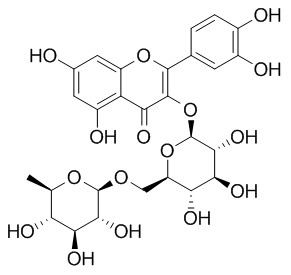Quercetin-3-o-rutinose
Quercetin-3-o-rutinose has antioxidative activity, it exerts strong DPPH radical-scavenging activity.
Inquire / Order:
manager@chemfaces.com
Technical Inquiries:
service@chemfaces.com
Tel:
+86-27-84237783
Fax:
+86-27-84254680
Address:
1 Building, No. 83, CheCheng Rd., Wuhan Economic and Technological Development Zone, Wuhan, Hubei 430056, PRC
Providing storage is as stated on the product vial and the vial is kept tightly sealed, the product can be stored for up to
24 months(2-8C).
Wherever possible, you should prepare and use solutions on the same day. However, if you need to make up stock solutions in advance, we recommend that you store the solution as aliquots in tightly sealed vials at -20C. Generally, these will be useable for up to two weeks. Before use, and prior to opening the vial we recommend that you allow your product to equilibrate to room temperature for at least 1 hour.
Need more advice on solubility, usage and handling? Please email to: service@chemfaces.com
The packaging of the product may have turned upside down during transportation, resulting in the natural compounds adhering to the neck or cap of the vial. take the vial out of its packaging and gently shake to let the compounds fall to the bottom of the vial. for liquid products, centrifuge at 200-500 RPM to gather the liquid at the bottom of the vial. try to avoid loss or contamination during handling.
Biomed Pharmacother.2023, 166:115329.
Evid Based Complement Alternat Med.2017, 2017:7383104
Applied Biological Chemistry2024, 67:66.
Biomolecules.2024, 14(10):1257.
RSC Advances2017, 86
J Food Sci.2021, 86(9):3810-3823.
Nutrients2022, 14(14)2929
Curr Issues Mol Biol.2024, 46(6):6018-6040.
J Food Biochem.2021, 45(7):e13774.
Heliyon.2024, 10(12):e31722.
Related and Featured Products
Phytomedicine. 2003;10(6-7):544-51.
Study on the inhibitory effects of Korean medicinal plants and their main compounds on the 1,1-diphenyl-2-picrylhydrazyl radical.[Pubmed:
13678241]
METHODS AND RESULTS:
The polyphenols isolated from these plants, procyanidin B-3, (+)-catechin, gallic acid, methyl gallate, quercetin, quercetin-3-O-beta-D-glucoside, quercetin-3-O-beta-galactoside, Quercetin-3-o-rutinose and kaempferol, exerted strong DPPH radical-scavenging activity.
CONCLUSIONS:
These results suggest that the Korean medicinal plants and the polyphenols isolated from them that exhibited effective radical-scavenging activity may be promising agents for scavenging free radicals and treating diseases associated with excess free radicals.
Am J Chin Med. 2003;31(6):907-17.
The inhibitory effects of 12 medicinal plants and their component compounds on lipid peroxidation.[Pubmed:
14992543]
The antioxidative activities of 12 medicinal plants and the compounds isolated from them were investigated using the thiocyanate method to evaluate inhibitory effects on lipid peroxidation in the linoleic acid system.
METHODS AND RESULTS:
The peroxide levels gradually increased during incubation in the presence of linoleic acid over 3 days, and most of the plants inhibited lipid peroxidation. In particular, of the plants tested, Cudrania tricuspidata, Zanthoxylum piperitum, Houttuynia cordata and Ulmus parvifolia reduced lipid peroxidation more effectively as lipid peroxidation progressed, resulting in inhibition of about 80% relative to the control value by the 3rd day of incubation. In addition, the polyphenols isolated from the plants also showed marked and dose-dependent inhibitory effects on lipid peroxidation. The compounds with the strongest activities were 3,4-dihydroxylbenzoic acid, quercetin, the quercetin glycosides quercetin-3-O-beta-D-galactoside, quercetin-3-O-alpha-L-rhamnoside, quercetin-3-O-beta-D-glucoside and Quercetin-3-o-rutinose, catechin, gallic acid, methyl gallate and rosamultin isolated from Zanthoxylum piperitum, Houttuynia cordata, Rosa rugosa and Cedrela sinensis. Moreover, quercetin glycosides showed stronger activity than quercetin, suggesting that glycosylation increases the antioxidative activity of quercetin.
CONCLUSIONS:
Our results indicate that the medicinal plants and their polyphenols show promise as therapeutic agents for various disorders involving free radical reactions.
J Pharm Biomed Anal. 1994 Mar;12(3):325-34.
Electrochemistry of catechol-containing flavonoids.[Pubmed:
8031931]
The electrochemical properties of four structurally related flavonoids, quercetin, quercetin-3-O-rhamnose (quercitrin), Quercetin-3-o-rutinose (rutin) and luteolin were investigated. These flavonoids were shown to undergo homogenous chemical reactions following oxidation at a glassy carbon electrode.
METHODS AND RESULTS:
These reactions were studied using cyclic voltammetry and rotating ring-disk voltammetry. Both first-order and zero-order processes were observed. The rate of the zero-order process was strongly dependent on the substituent at the C-3 position of the flavonoid. The rate of the first-order process was independent of substitution. Two products were observed using liquid chromatography.
CONCLUSIONS:
These products did not correspond to previously reported products of enzymatic oxidation. The products were not stable under conditions for isolation.



